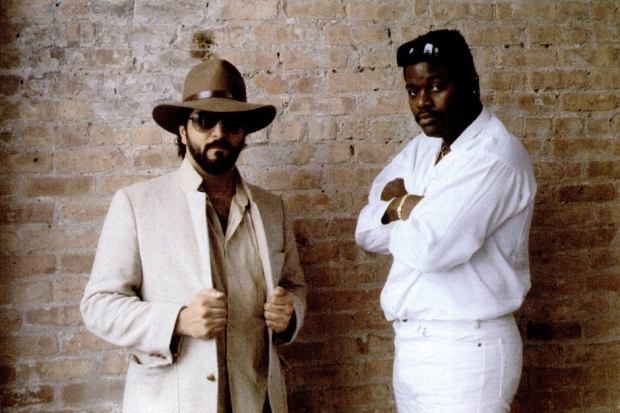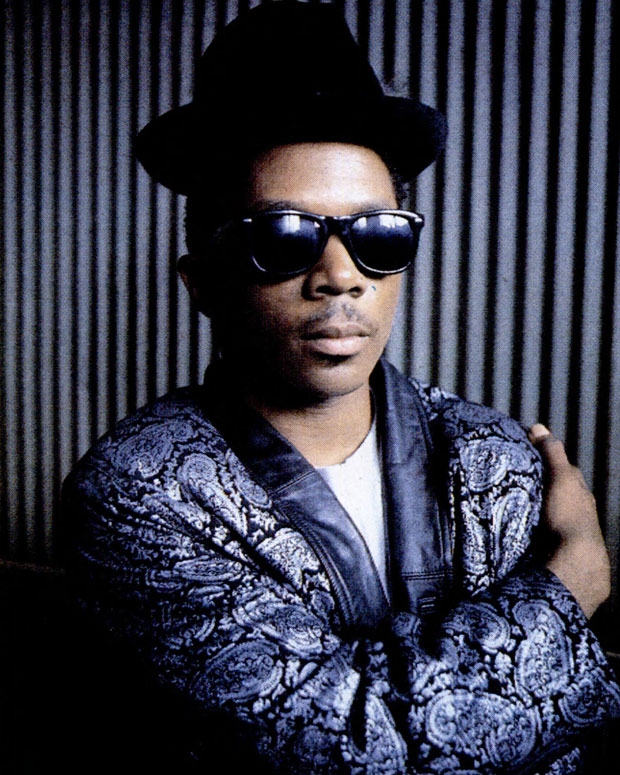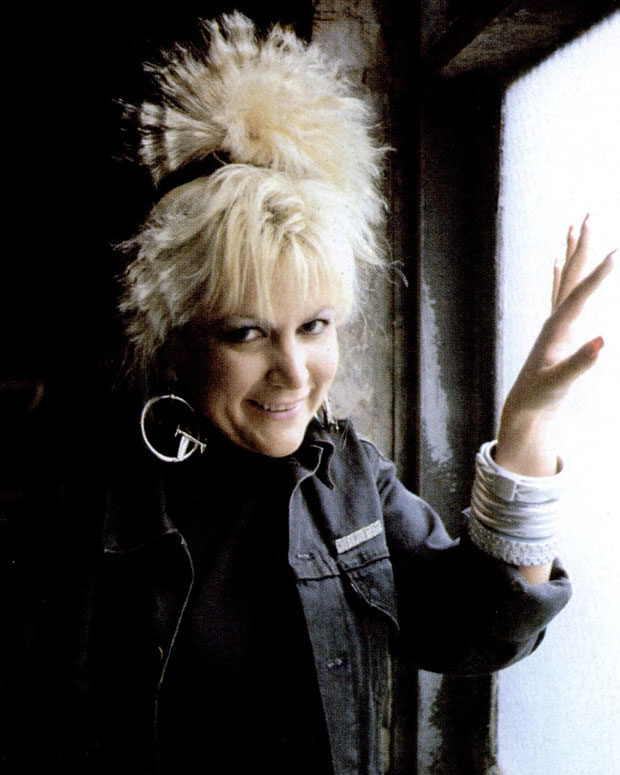“Burning Down the House” originally appeared in SPIN’s November 1986 issue.
To get to Imports Etc. you once had to walk through a garage. Now you just need to know where it is. Located on a side street in Chicago’s Printers Row, the city’s only record store dealing exclusively in dance music hangs its little yellow sign on a sealed-off garage door. New 12-inch singles share bin space with old Philadelphia soul and obscure Italian imports that sell to collectors for up to $20. Most of Imports Etc.’s customers are DJs. They come here for house music.
At C.O.D., a dark, run-down juice bar on Chicago’s North Side, DJ Frankie Knuckles spins for a cramped room full of sweaty blacks jacking their bodies in furious sexual pantomime until eight AM. Knuckles drops out everything from a Teddy Pendergrass record except the voice. The crowd reacts like they’re at a revival meeting, screaming in response to Teddy’s testimony. They worship Knuckles as the man who invented house music.
On WGCI, Farley “Jackmaster” Funk goes on the Chicago airwaves as part of the Hot Mix 5, and thousands of listeners turn their dials to pick up his show. He plays a musical collage of thunderous beats. None of the records in his set will ever make the Top 40. They haven’t even been released yet, but his fans know exactly what he’s playing. Farley claims he invented house music.

Also Read
Compact Discs: Sound of the Future
House music is HARD disco. It goes BOOM BOOM BOOM BOOM with little variation, subtlety, melody, instrumentation — or music for that matter. House, by definition, ain’t crossover. It’s in the house, and it won’t come out.
House music is made by people with names like Chip E., Jack N. House, Farley “Jackmaster” Funk, Jack the Dick, the Jackin’ 5, the It, and House People. They make songs called “Love Can’t Turn Around,” “I Can’t Turn Around,” “Like This,” “Sample That,” “Move Your Body (The House Music Anthem),” “Jack Your Body,” “Time to Jack,” “Jack the Bass,”and “Jack the Dick.” These songs come on 12-inch singles (there are no house albums) in multiple versions called the House Mix, the Fierce Mix, the “Jack for Daze” mix, the a cappella, the Houseapella, and the Dickapella mix.
As that interchangeable list suggests, house music is about taking something old and reshaping it into something new, if not always different. House stars are rarely singers and musicians. The name performers are DJs who’ve graduated to become synth programmers and producers. Their stark, electronic productions are like what remixes would make if they didn’t have records to remix.
House is bricolage, for it borrows from obscure Italian disco records that imitate New York club records that draw from Philadelphia soul that grew out of Detroit black pop. House is motivated by an obsession to possess the inaccessible: imported European 12-inch disco singles that appear one week and are gone the next, unlikely picks from long out-of-print albums, bootlegs, and commercially unreleased DJ-only remixes. To be into house you have to be resourceful, dedicated, and willing to sacrifice a big chunk of your paycheck to track down the right records. House makes demands.
Just like New York rap is about rap and Washington go go is about go go, Chicago house is about house. It is new disco both glorifying and deconstructing the old. Chip E.’s “Like This” takes its bass line and title from the South Bronx’s ESG club hit “Moody.” Farm Boy’s “Move” quotes Grace Jones’s “Slave to the Rhythm,” Farley “Jackmaster” Funk and Jesse Saunders’s “Love Can’t Turn Around” is a remake of Issac Hayes’s “I Can’t Turn Around,” J.M. Silk’s “Music Is the Key” recalls Colonel Abrams’s “Music Is the Answer,” and Fresh’s “Dum-Dum” gets its title from George Kranz’s “Din-Da-Da” (which ripped off Martin Circus’s “Disco Circus”) and snatches long excerpts from Shelia E.’s “The Glamorous Life” and Funkadelic’s “One Nation Under a Groove.” House records generally get their bass lines and rhythms from lengthy early disco workouts like MSFB’s “Love Is the Message” and First Choice’s “Let No Man Put Asunder,” while their barren synth textures and Eurodisco tempos come from Italian dance records. This is music born of digital sampling devices. “We in Chicago don’t consider borrowing ideas from old records stealing,” says 20-year-old Chip E., the godfather of house. “After all, a Dj’s job is to take something old and create something new out of it. Stealing is hearing someone’s new ideas and recording them before they do.”
The sensibility behind all the borrowing is more like a young, black d.i.y. attitude combined with gay camp. Repetitive rhythms, off-key vocals, inane lyrics, and synthesizers that beep like push-button phones come on with such single-minded determination that they become endearingly human, if only because they’re so inept. House records use cheap equipment and sound it, because everyone involved is relatively new at this stuff. None of the local labels that crank out house is more than a year old, and there’s not enough money in any one place to get fussy. Many house pressings are just like authentic Jamaican reggae rockers: They often snap, crackle, and pop louder than the percussion. Rocky Jones, head of the biggest house label, DJ International, says his 12-inch singles cost an average of $3,000 to make. One, Tyree’s “I Fear the Night,” which came out on his Underground affiliate, cost only $50.
Disco, the dance music that dares not say its name, is back in the mainstream. Whether it’s Janet Jackson or the Blow Monkeys or Nu Shooz or Madonna or Michael McDonald or the Pet Shop Boys, disco has made an unacknowledged comeback through a staggering array of newwaveretroelectrofunk permutations. But for its core audience, blacks and gays, it never went away. They had created disco as their own underground escape from the very same mainstream that eventually whitewashed it with Disco Beethoven, Disco Rod Stewart, and Disco Duck, and they continued to develop it. Small New York indie labels like Salsoul, West End, and Prelude became big indies by making records not designed to cross over but to satisfy the demands of a fiercely devoted, club-going audience. In New York the private after-hours gay club Paradise Garage and its DJ Larry Levan have kept turning out a hip but no-nonsense party crowd with big beats faster than rap but not as frantic and far more funky than the hi-NRG favored at gay white clubs. In Chicago former New York DJ Frankie Knuckles provided a similar sound from 1977 to 1983 at a gay black club called the Warehouse. Like Levan, Knuckles mixed dubbed-up inspirational electronic funk cult jams by the Peech Boys and D Train with ’70s black disco classics by Loleatta Holloway and South Shore Commission. Knuckles spun what other jocks had long forgotten or never had the nerve to play, creating a following of dancers who came just to hear his signature sound. They called this sound Warehouse music. For short, house music.
Knuckles rival at the Playground, Farley Keith, describes how house got its name a little differently. “Chicago radio had never heard of mixing before 1981. Programmers wanted DJs to play commercial R&B. I wanted to be different, so I played imports. I gave imports the name house because nobody in the whole city was playing it. I brought them to the club, and the first couple of times I got a few frowns. But after a while people at the Playground were going nuts, and everybody started playing imports because they didn’t want to be left behind. The DJ became such a force that the music he played became his music, and people would accept it. Because I played an import like ‘Brainwash’ [by the Belgian group Telex with English lyrics by Sparks], other DJs picked up one it, and Imports Etc. sold 1,000 copies in two weeks.
“After everyone jumped on the bandwagon and played what I was playing, it wasn’t special to me anymore. So then I brought my drum machine to the club and learned to play records that used the same machine, like ‘Dirty Talk’ by Klein and MBO. Frankie Knuckles and I used to play many of the same records, but whereas he would play a song from beginning to end or make a re-edited version at home and bring it in to the Warehouse, I played my drum machine along with the records so that the crowd could really feel that heavy, heavy foot. To play a record like Shannon’s ‘Let the Music Play’ that didn’t have a really driving foot was to get tomatoes thrown at you. You had to drive them with your beat. Call me the foot doctor.”
House music was first moved out of the clubs when Keith organized WBMX-FM’s Hot Mix 5, piecing together fragments of dance cuts into a seamless groove. Keith claims to have been the first to play obscure oldies, imports, drum machines, and early rhythm-only tracks like “On and On” by Chicago’s Jesse Saunders. “With Jesse making records in ’82, he gave everyone the confidence to believe in themselves,” Keith acknowledges. “People thought, ‘If he can make records, shit, I can make ’em too.’ That went into the mind of every DJ.”As the DJs turn producers, they bring their rough mixes to the Hot Mix 5. Exposure on these shows creates a demand for a record even before it is released and ensures the producer of turning enough profit to make the next rough mix, and the process repeats itself. According to Farley, “J.M. Silk’s ‘Music Is the Key’ was played on our mixes and in the clubs so much before it was released that it sold 2,000 copies the day it finally came out.”
“Today’s house music is built around a straight foot going BOOM BOOM BOOM BOOM, with every beat and a bass line playing eighth notes. It isn’t very melodic and doesn’t fill up the whole spectrum. House records aren’t real busy. And where a snare drum would establish the beat in a rock record, the foot establishes the house beat. Heavy-voiced guys like Colonel Abrams or a woman like Loleatta Holloway are best. House music is also trying to find something mysterious or old to play. Everybody can’t play old records, because you can’t find them. And if they’re reissued, then they’re no big deal anymore because everyone can’t get them. The lyrical content has to be right or else it isn’t house.”
House lyrical content consists of dancing and sex. “Jacking your body”(moving up and down on a dance floor) can easily slide into sex. Especially on Farley Keith’s records. On his first, “Aw Shucks”by Jackmaster Funk, a black Betty Boop voice squeaks at the onset, “Hey big boy, are you gonna make the feel the bass on this record?”It then screams “Ohhh, work my body down to the floor,”and then propositions, “Farley come here and let me jack your little dick, too.” Like the incessantly booming beat, house sexuality is reduced to absurdly aggressive basics, but not without a self-mocking playfulness and an underlying message of liberation. “Jack the Dick”by Jackmaster Dick repeats the phrase “Suck my dick, bitch” several dozen times at various speeds before evolving into the chant, “Suck my motherfuckin’ dick, bitch.” For Chicago’s black gays threatened by AIDS, jacking the night away at an after-hours club has become the most physically gratifying alternative to sex. “Around 1984, when people started becoming aware that there was a real house scene,” says Chip E., “people also became aware of everyone else being gay. It became really fashionable to flit around. Everybody wanted to be gay. Now everybody wants to be a DJ.” Sex becomes on record both obsessively salacious and absurd. Nowhere is this more explicit than on “Sensuous Woman Goes Disco” by Jackmaster Dick’s Revenge. In a monologue from a comedy album, a Sensuous Woman proclaims, “I intend to put something on your mind and leave your dick tingling. Wait a minute now. You know you got a big dick, motherfucker. Take your time.” Chip E. explains: “Some of the music is explicitly sexual because some of the individuals are explicitly sexual. House is suited for the way people dance now, which is like being in bed but standing up. ‘Jacking’ is to house as ‘boogying’ was to disco. We gear our music for dancing, not for radio. We don’t have people telling us what we can or cannot do.”Chip E.’s mom wrote the lyrics to his recent production, “Godfather of House” by House People.
Chip E. is a typical house story. “I was a DJ for about six years. And I noticed the simplicity of a lot of the imports that were selling at the record store I was working at, Imports Etc. I sold my brand-new turntables for a few hours time at an eight-track studio. I borrowed some keyboards and drum machines to have an acetate made, and my friends in the Hot Mix 5 started playing it immediately. Right away people started asking for it at the store. I borrowed my mother’s income-tax check and had one thousand copies pressed. We sold five hundred the first day and the other five hundred went within the week.”Chip E.’s next single, ‘Like This’ has sold about 40,000 copies, but an estimated half of them were bootlegs, which continues to be a local problem.
In a typical house record, vocalists are just accessories to the beat. They’re there so people will remember what record to buy. Singers often don’t get anywhere near the right notes and sometimes don’t even try to interpret the lyrics. Another connection with Italian disco. On a Farley import favorite like “Feel the Drive” by Doctor’s Cat, the Italian singers try to imitate black Americans while attacking the thoroughly insipid lyrics with severe solemnity. They sound, naturally, like Italians phonetically imitating black Americans without a clue about what they are singing. This doesn’t bother house people.
Two exceptions to this pattern are Screamin’ Rachael and Darryl Pandy. Rachael, a punky blonde, ran a new-wave club called the Space Place out of a former food-storage building. “The police raided my club almost every week,” she screams. “But since I wasn’t doing anything wrong, the only way they could stop me was to condemn the building.” She went for advice to the Hot Mix 5 and Jesse Saunders, who collaborated with her on “Fantasy,” an early house record that sounds like Blondie on a beatbox budget. She has since worked with Afrika Bambaataa and Colonel Abrams and eventually found an ironic ticket to exposure. “I just did a commercial for Seagrams’s Bruce Juice wine cooler they’re aiming for the young urban audience. I guess Seagrams thinks that house is just the right sound they need to reach that market.”
Darryl Pandy is an enormous man, a Refrigerator Perry gone disco diva. He comes from a Broadway and opera background and has a six-and-a-half octave range. Ask him to to prove it and he’ll gladly sing selections from Porgy and Bess, taking on both Porgyand Bess. On record, most notably “Love Can’t Turn Around,”Pandy resembles a possessed cross between his idols Yma Sumac and Minnie Ripperton, with a dark trace of Loleatta Holloway. Like Doctor’s Cat, Pandy sings with emotions endearingly inappropriate to the material. He begins “Love Can’t Turn Around”with all the hypermasculinity of an ill-fated Wagnerian baritone, to come back in the third verse as Screamin’ Jay Hawkins. His dynamics are so ridiculously wrong by contemporary R&B standards that they become absolutely right for house.
Pandy’s histrionics are emblematic of the house scene in general. House is about the loss of decorum and control. From sexual extravagance to dance-floor excess, everything about house is geared toward losing it. The mania for obscure dance records, their inflated prices, the vocalists who can’t stay on pitch, the fly-by-night labels that pump out more records than most people can keep up with, the mixes that sound like they could damage your woofers and tweeters, and the pressings that sound like eggs frying behind the music all add up to a scene spinning off its axis. Whether it refers to dancing or fucking, Gary B.’s whispered chant of “Release my soul / I’ve lost control / I’m too far gone / Ain’t no way back” on Adonis’s “No Way Back” serves as the house prayer for deliverance.
As intense as the house party gets, these Chicagoans still retain a sense of community. When Pandy declares, “Ohhoho, you just look so good. (gasp) Standing right there (gasp) waiting for a big, (gasp) good-looking man like me to (gasp) come over there and run my hands (gasp) in your long, beautiful black hair and look into your big, beautiful (gasp) brown eyes and kisss your sssensssousss lipsss,” the house audience knows he’s doing a Loleatta Holloway/Issac Hayes/Teddy Pendergrass love-rap thing, and he makes perfect sense. To the rest of the world, however, Pandy’s sensuality may seem grossly overstated. Like every cult music, house is a set of codes, a language mutually understood by those who speak it but deliberately foreign to outsiders. Despite the tension created by major labels coming in to take away talent (Geffen has Jesse Saunders and the Bang Orchestra, RCA has J.M. Silk, and other labels have courted D.J. International), the music makers themselves still all work on each other’s projects, resist outside attempts to slow down their furious production pace, and generally hang together like a family. As Screamin’ Rachael puts it, “What you see with D.J. International is like a new Chess label appearing. We’ve got a lot of blues soul, and gangster influences. After all, we are from Chicago.” ??







